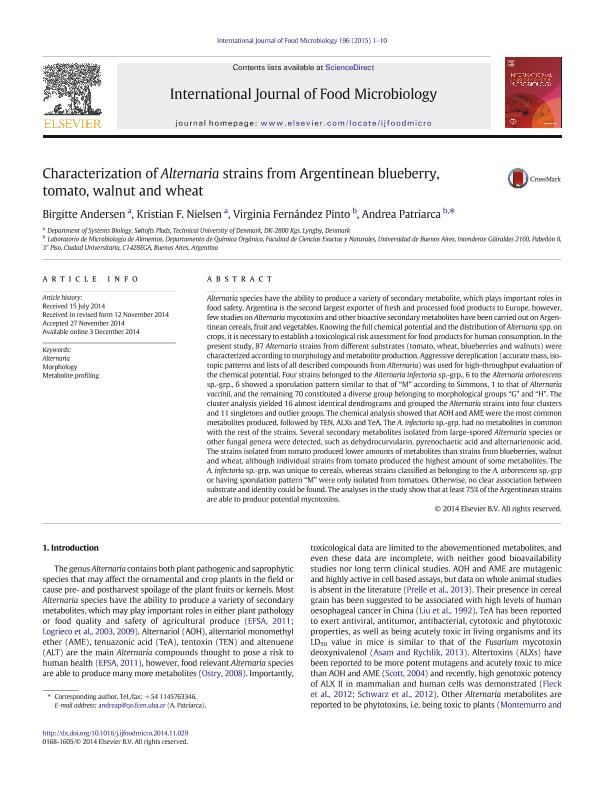Mostrar el registro sencillo del ítem
dc.contributor.author
Andersen, Birgitte

dc.contributor.author
Nielsen, Kristian F.

dc.contributor.author
Fernández Pinto, Virginia

dc.contributor.author
Patriarca, Andrea Rosana

dc.date.available
2017-05-19T16:31:19Z
dc.date.issued
2014-12-03
dc.identifier.citation
Andersen, Birgitte; Nielsen, Kristian F.; Fernández Pinto, Virginia; Patriarca, Andrea Rosana; Characterization of Alternaria strains from Argentinean blueberry, tomato, walnut and wheat; Elsevier Science; International Journal of Food Microbiology; 196; 3-12-2014; 1-10
dc.identifier.issn
0168-1605
dc.identifier.uri
http://hdl.handle.net/11336/16734
dc.description.abstract
Alternaria species have the ability to produce a variety of secondary metabolite, which plays important roles in food safety. Argentina is the second largest exporter of fresh and processed food products to Europe, however, few studies on Alternaria mycotoxins and other bioactive secondary metabolites have been carried out on Argentinean cereals, fruit and vegetables. Knowing the full chemical potential and the distribution of Alternaria spp. on crops, it is necessary to establish a toxicological risk assessment for food products for human consumption. In the present study, 87 Alternaria strains from different substrates (tomato, wheat, blueberries and walnuts) were characterized according to morphology and metabolite production. Aggressive dereplication (accurate mass, isotopic patterns and lists of all described compounds from Alternaria) was used for high-throughput evaluation of the chemical potential. Four strains belonged to the Alternaria infectoria sp.-grp., 6 to the Alternaria arborescens sp.-grp., 6 showed a sporulation pattern similar to that of “M” according to Simmons, 1 to that of Alternaria vaccinii, and the remaining 70 constituted a diverse group belonging to morphological groups “G” and “H”. The cluster analysis yielded 16 almost identical dendrograms and grouped the Alternaria strains into four clusters and 11 singletons and outlier groups. The chemical analysis showed that AOH and AME were the most common metabolites produced, followed by TEN, ALXs and TeA. The A. infectoria sp.-grp. had no metabolites in common with the rest of the strains. Several secondary metabolites isolated from large-spored Alternaria species or other fungal genera were detected, such as dehydrocurvularin, pyrenochaetic acid and alternarienonic acid. The strains isolated from tomato produced lower amounts of metabolites than strains from blueberries, walnut and wheat, although individual strains from tomato produced the highest amount of some metabolites. The A. infectoria sp.-grp. was unique to cereals, whereas strains classified as belonging to the A. arborescens sp.-grp or having sporulation pattern “M” were only isolated from tomatoes. Otherwise, no clear association between substrate and identity could be found. The analyses in the study show that at least 75% of the Argentinean strains are able to produce potential mycotoxins.
dc.format
application/pdf
dc.language.iso
eng
dc.publisher
Elsevier Science

dc.rights
info:eu-repo/semantics/openAccess
dc.rights.uri
https://creativecommons.org/licenses/by-nc-nd/2.5/ar/
dc.subject
Alternaria
dc.subject
Morphology
dc.subject
Metabolite Profiling
dc.subject.classification
Alimentos y Bebidas

dc.subject.classification
Otras Ingenierías y Tecnologías

dc.subject.classification
INGENIERÍAS Y TECNOLOGÍAS

dc.title
Characterization of Alternaria strains from Argentinean blueberry, tomato, walnut and wheat
dc.type
info:eu-repo/semantics/article
dc.type
info:ar-repo/semantics/artículo
dc.type
info:eu-repo/semantics/publishedVersion
dc.date.updated
2017-05-02T18:17:18Z
dc.journal.volume
196
dc.journal.pagination
1-10
dc.journal.pais
Países Bajos

dc.journal.ciudad
Amsterdam
dc.description.fil
Fil: Andersen, Birgitte. Technical University Of Denmark; Dinamarca
dc.description.fil
Fil: Nielsen, Kristian F.. Technical University Of Denmark; Dinamarca
dc.description.fil
Fil: Fernández Pinto, Virginia. Universidad de Buenos Aires. Facultad de Ciencias Exactas y Naturales. Departamento de Química Orgánica; Argentina
dc.description.fil
Fil: Patriarca, Andrea Rosana. Universidad de Buenos Aires. Facultad de Ciencias Exactas y Naturales. Departamento de Química Orgánica; Argentina. Consejo Nacional de Investigaciones Científicas y Técnicas. Oficina de Coordinación Administrativa Ciudad Universitaria. Instituto de Micología y Botanica. Universidad de Buenos Aires. Facultad de Ciencias Exactas y Naturales. Instituto de Micología y Botanica; Argentina
dc.journal.title
International Journal of Food Microbiology

dc.relation.alternativeid
info:eu-repo/semantics/altIdentifier/url/http://www.sciencedirect.com/science/article/pii/S0168160514005807
dc.relation.alternativeid
info:eu-repo/semantics/altIdentifier/doi/http://dx.doi.org/10.1016/j.ijfoodmicro.2014.11.029
Archivos asociados
